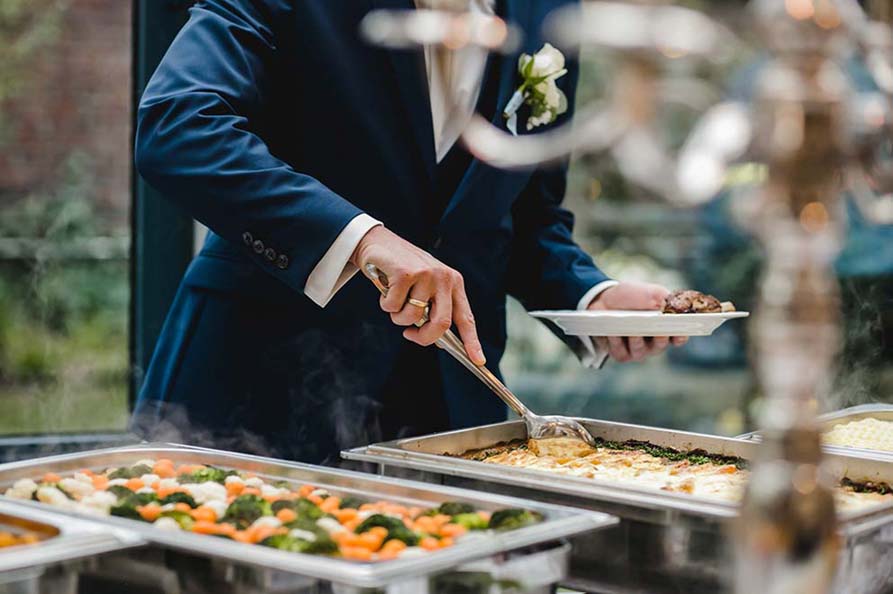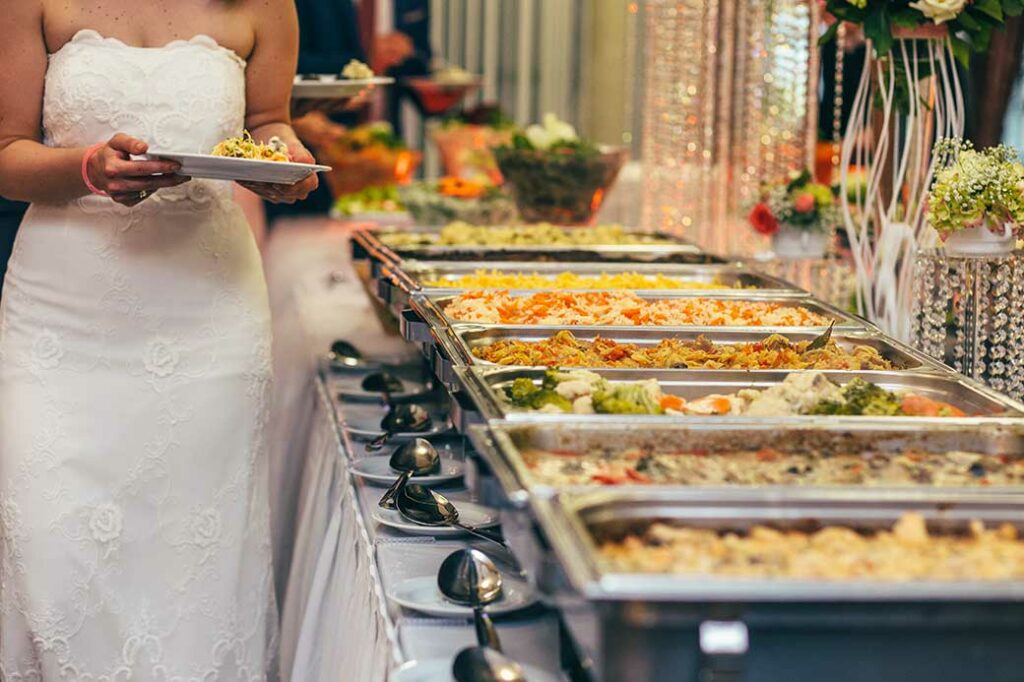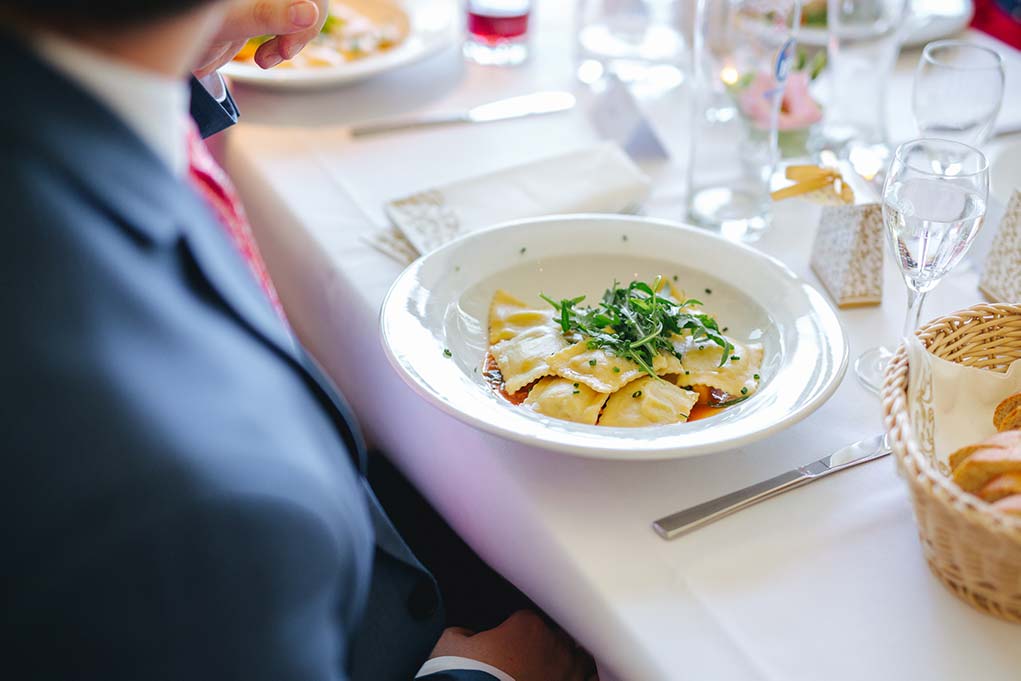
Buffet or Plated Wedding Dinner?
Food tends to be the foundation of bringing people together, and it’s definitely an integral part of most celebrations. The decision to have food at your wedding is an easy one, and now you just have to decide what’s on the menu. Do you want your guests to have a choice of what they eat or would you prefer a plated meal to be served to everyone? This decision can be tough, so we’ll compare the two options and determine which wins in different categories to help you decide which is best for your wedding reception!
The following five categories are important ones to take into consideration as you decide what wedding reception meal to have:
1. Cost
Buffet style meals are a good way to save money on serving staff, since you won’t need multiple servers on hand to deliver all the plates in a timely manner. The labor required to prepare the food is also less expensive, as large quantities are easy to cook and transfer into warming trays.
Both options will require some cleanup after the meal, but using nice disposable tableware and plates for a buffet makes it easy for guests to take care of their own trash. Most wedding caterers will use plates and utensils that can be washed to serve plated meals, and those will need to be collected by staff after the meal is complete.
Winner of the cost category: Buffet

2. Options
Buffet style meals typically consist of more than one type of entree, plus sides. This gives your guests options while they dish up, so you can appease those picky eaters and make sure guests with dietary restrictions can enjoy the meal.
Plated meals are entirely predetermined, even if you go for a couple of entree options for your guests to choose from. To avoid issues with food allergies and dietary restrictions, you’ll need to let your caterer know ahead of time which guests need substitutions or omissions of certain dishes. This leaves picky eaters stuck with the “get what you get” mentality.
Winner of the options category: Buffet
3. Food Waste
Serving a plated meal to your guests means they won’t be able to turn down any foods they won’t (or can’t) eat. They also won’t be able to determine their own portion sizes, and although your caterer will know what portion sizes are usually good to serve, there may still be guests that either won’t be able to finish their entire meal or won’t feel like they’ve gotten enough to eat. With that said, purchasing the right number of plated meals can definitely mean less food waste. It’s important to consider what percentage of wedding guests will show up (the number is almost always less than your RSVP list).
On the other hand, “free” all you can eat food tends to encourage the condition where people’s eyes become bigger than their stomachs, which almost always results in oversized scoops being thrown out.
Most caterers will let you take home leftovers from either of the options, but it’s always a good idea to check ahead of time. If you do take home leftovers, giving some to family and friends or freezing the excess will help with the “out of sight, out of mind” dilemma that tends to cause a lot of food waste.
Winner of the food waste category: Plated (although this could go either way, plated meals tend to cause less food to be thrown out).

4. Waste
Depending on the decor and setup of your reception venue, a plated dinner may be easier than determining a path and space for your guests to line up for the buffet. Plated meals also eliminate the need to have space reserved for a buffet setup, which will definitely come in handy if you need extra space for the dance floor.
It’s safe to say that a buffet will always take up more space. However, if your caterer or venue provides staff to help you clean up after the meal, taking down the buffet and rearranging the space can free up space for a dance floor after the meal.
Winner of the space category: Plated
5. Practicality
The serving style that’s best for your reception also depends on if you want an informal or a formal wedding. Buffets tend to provide a relaxed atmosphere, where people are free to move around and take their time to finish their meal. It also gives them the opportunity to go back for seconds if they want to. If you and your partner know that most of your guests prefer a casual dining environment, they may be more comfortable with a buffet style meal.
Plated meals are usually more than one course, so they tend to create more of a fine dining atmosphere. They can also make it easier for your guests to get refills on drinks, since servers will be coming around to check up on them and collect dishes. Plated meals are usually easier for the bride and groom, as well. Since the two of you have chosen all the dishes, you know exactly what you’ll be getting and you don’t have to make your way through the wedding venue setup to get your food or drinks.
Winner of the practicality category: Tie (this one really depends on your venue and personal preferences).
As with all of the wedding planning process, there is no one right answer and we know you have a lot of things to consider. Hopefully these comparisons help you plan your reception dinner, and don’t forget to check back for more helpful tips and guides in our blog!
